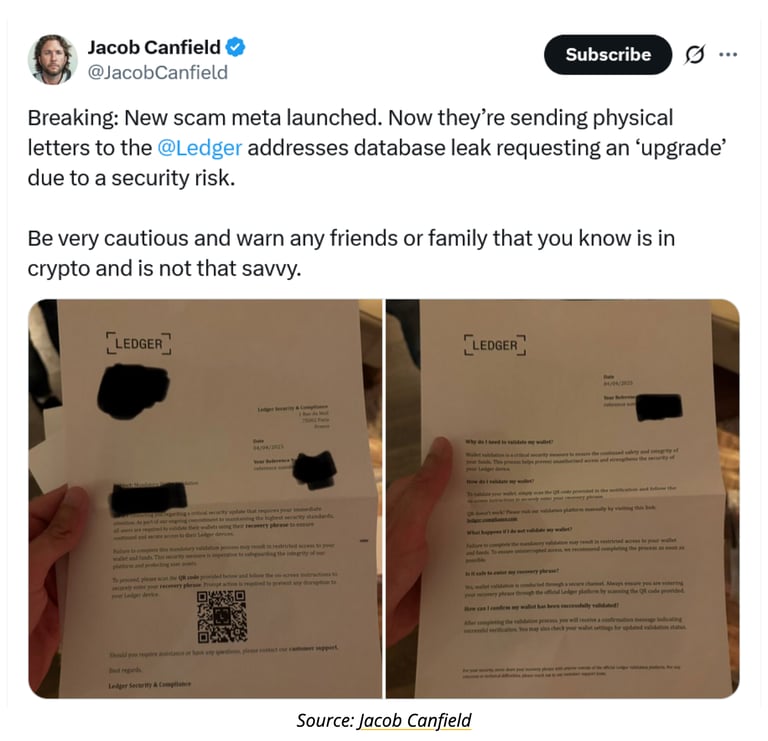
Aug 14, 2025
14 August 2025 Ledger owners are being urged to act now. A sharp rise in phishing emails, fake update prompts, and spoofed support messages is putting hardware-wallet users at risk. Security experts say a quick “genuine check” and firmware review inside Ledger Vault, taking less than two minutes, can confirm a device’s authenticity, ensure it’s on the latest firmware, and stop suspicious prompts before they escalate.


Ledger Owners Urged to Run Two-Minute Firmware Health Check as Phishing Lures Rise
While transactions on Ledger devices still require physical confirmation, recent cases show that attackers are exploiting connectivity and API weaknesses to harvest wallet metadata and increase the chances of targeted scams. Running an official diagnostic directly inside Ledger Live reduces this exposure and keeps the update process under the user’s full control.
Consider the experience of “Amira K.,” a long-term BTC and ETH holder in London who uses a Ledger Nano X. She first noticed something was amiss when Ledger Live began throwing an unfamiliar connectivity-retry message after she had postponed an earlier firmware reminder. The same afternoon, an email landed in her inbox claiming a critical update was required and urging her to click a button that, on closer inspection, led to a domain with an extra hyphen tucked into the URL. “It felt off,” she recalled. “I’d seen warnings about look-alike links, and I didn’t want to gamble.”
Amira took the conservative route. She opened Ledger Live—making sure the app itself was up to date—connected and unlocked her device, and navigated to the Manager section to run the Genuine Check. The tool confirmed the device was authentic but flagged an outdated firmware version with a verified update available. She completed the update entirely inside Ledger Live, kept the device connected throughout, and then repeated the Genuine Check. Within minutes the status read “Device is genuine” with the current firmware listed beneath. The suspicious retry prompt disappeared on the next launch. “Seeing that line in the app calmed me down immediately,” she said. “It took less than two minutes, and I never had to enter anything sensitive.”
Her story echoes the advice circulating across prominent crypto forums, where moderators and independent security educators have been unified on the basics: keep Ledger Live current, verify authenticity with the Genuine Check, and apply firmware updates exclusively through official in-app prompts rather than through emailed links or browser pop-ups. Reader messages to this desk over recent months have often described the same pattern—anxiety triggered by an aggressive email followed by relief after a quick, official verification inside Ledger Live. For many, the two-minute health check has become a confidence-building habit they repeat after any update notice or whenever something simply feels off.
Running the diagnostic is straightforward. Users should open Ledger Live on desktop or mobile and confirm the application itself is on the latest version. After connecting and unlocking the device, they can open the Manager section and trigger the Genuine Check, following the on-screen instructions. If a firmware update is recommended, it should be completed within Ledger Live and not via any third-party website, email link, or unsolicited pop-up. Repeating the Genuine Check at the end provides a clear confirmation that the device is genuine and the firmware is current.
Trust remains the decisive factor in this climate, and it starts with a simple rule: no legitimate diagnostic or support flow will ever ask for a 24-word recovery phrase or PIN. Any site, message, extension or person requesting those details should be treated as malicious, no matter how urgent the language or how official the branding appears. Users are also encouraged to double-check URLs character by character, avoid installing unvetted browser extensions, and be skeptical of unsolicited direct messages that offer “support” or “priority upgrades.”
For readers who want to act now, the safest route is to launch Ledger Live directly and begin the check from within the app. Those unfamiliar with the workflow can consult the official help center for device-specific guidance. Both paths keep the process anchored to trusted resources and away from opportunistic impersonators.






